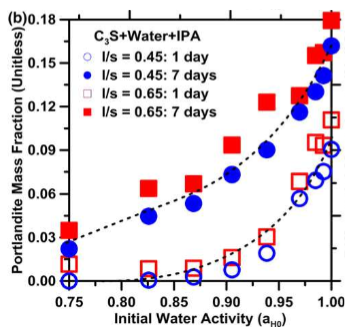Abstract
Tricalcium silicate does not undergo hydration at relative humidities (RH’s) below 80%. But, the rate at which its hydration rate decreases as a function of the RH has not yet been elucidated. By invoking correspondence between RH and water activity (aH, unitless), both of which are related to the chemical potential of water, the reaction evolutions of triclinic tricalcium silicate (i.e., T1-Ca3SiO5 or C3S) are tracked in water + isopropanol (IPA) mixtures, prepared across a wide range of water activities. Emphasis is placed on quantifying the: (a) rate of hydration as a function of aH, and (b) the critical (initial, aH0c or the achieved) water activity at which hydration effectively ceases, i.e., does not progress; here identified to be ≈ 0.70. The hydration of tricalcium silicate is arrested even when the system remains near saturated with a liquid phase, such that small, if any, capillary stresses develop. This suggests that changes in chemical potential induced via a vapor-phase or liquid-phase route both induce similar suppressions of C3S hydration. A phase boundary nucleation and growth (pBNG) model is fit to measured hydration rates from the onset of the acceleration period until well beyond the rate maximum when the water activity is altered. The simulations suggest that for a fixed hydrate nucleation density, any water activity reductions consistently suppress the growth of hydration products. Thermodynamic considerations of how water activity changes may influence reactions/hydrate evolutions are discussed. The outcomes improve our understanding of the chemical factors that influence the rate of Ca3SiO5 hydration.
